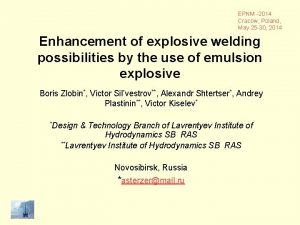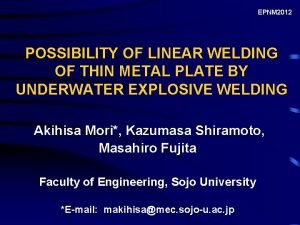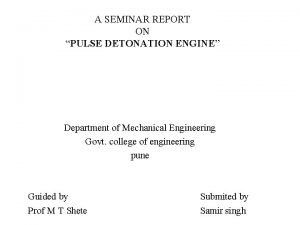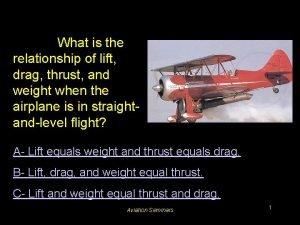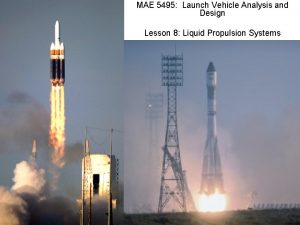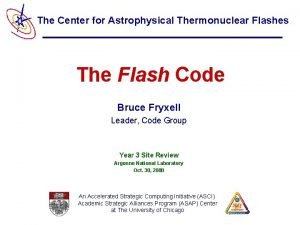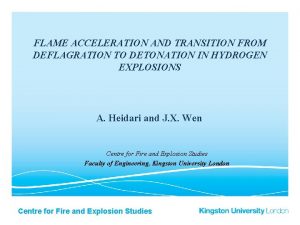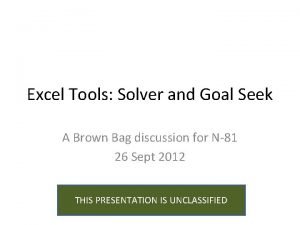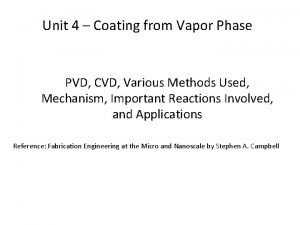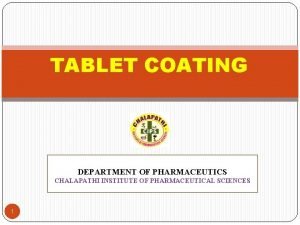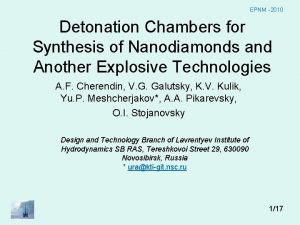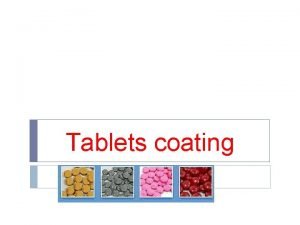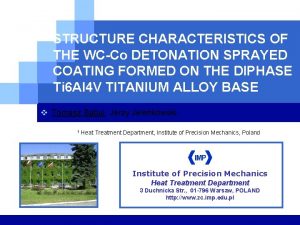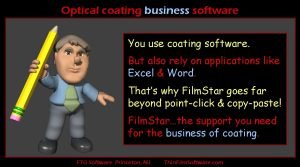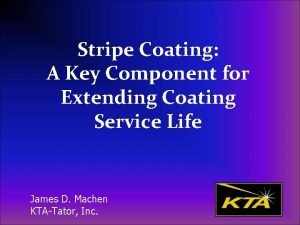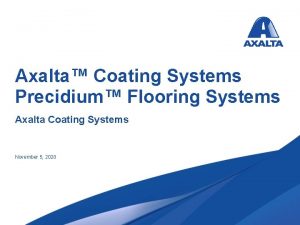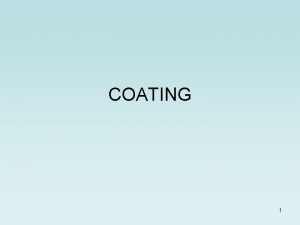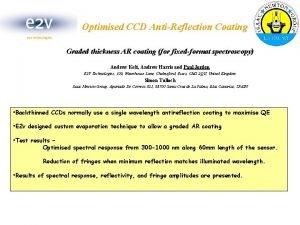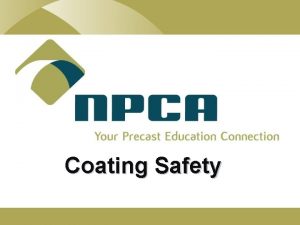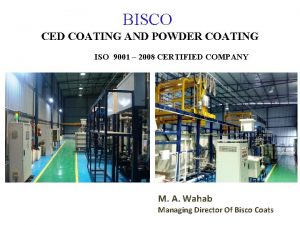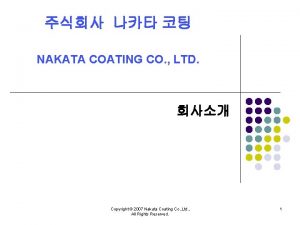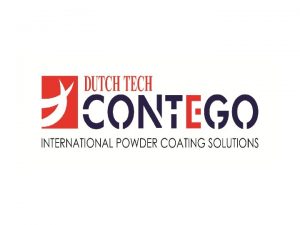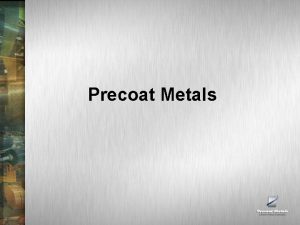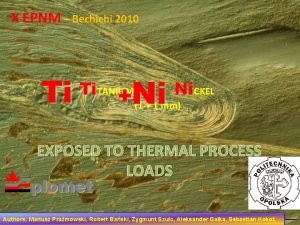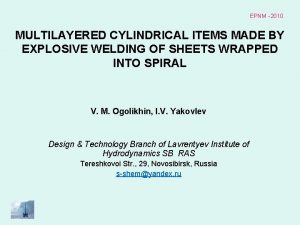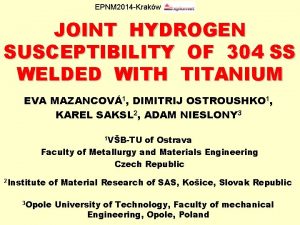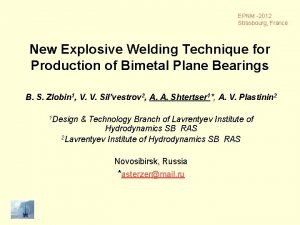EPNM 2010 USE OF GAS DETONATION FOR COATING






















- Slides: 22

EPNM -2010 USE OF GAS DETONATION FOR COATING DEPOSITION: DETONATION SPRAYING V. Yu. Ulianitsky, A. A. Shtertser*, S. B. Zlobin Lavrentyev Institute of Hydrodynamics SB RAS Lavrentyev avenue, 15, Novosibirsk, 630090, Russia *asterzer@mail. ru

EPNM -2010 Detonation Spraying (DS) is one of explosive technologies and can be attributed to Explosive Working of Materials. It is based on gas detonation phenomenon. DS is used for deposition of powder coatings (metal, ceramic, composite and etc. ) onto different substrates, mainly on metallic surfaces. At first DS was employed in 1950 s in USA [1, 2], and later on in 1960 s in USSR [3]. Comprehensive review of technological application of gas detonation is done in [4]. DS is particularly effective in deposition of WC-based hard alloy coatings [5] 1) R. M. Poorman, H. B. Sargent, and H. Lamprey. Method and Apparatus Utilizing Detonation Waves for Spraying and other Purposes. US Patent No. 2714563, Aug. 2, 1955. 2) John F. Pelton. Flame Plating Using Detonation Reactants. US Patent No. 2972550, May 28, 1958. 3) Bartenev S. S. , Fedko Yu. P. , Grigorov A. I. Detonation Coatings in Machinery Building. – Leningrad: Mashinostroenie, Leningrad section, 1982. 4) Yu. A. Nikolaev, A. A. Vasiliev, V. Yu. Ulianitsky. Gas Detonation and its Application in Engineering and Technologies (Review) // Combustion, Explosion, and Shock Waves. 2003, vol 39, No. 4. P. 382 -410. 5) S. B. Zlobin, V. Yu. Ulianitsky, A. A. Shtertser. Comparative Analysis of Nanostructured and Microstructured Cermet Detonation Coatings // Uprochnayushie Technologii I Pokrytia. 2009, No. 3. P. 3 -11.

EPNM -2010 Gaseous and Liquefied Fuels H 2 - hydrogen CH 4 – methane C 2 H 2 – acetylene C 2 H 4 – ethylene C 2 H 6 – ethane C 3 H 6 – propylene C 3 H 8 – propane C 4 H 10 – butane Liquefied hydrocarbons - propane + butane (70/30, 60/40, 50/50) MAPP – liquefied petroleum gas mixed with methylacetylene (propyne)propadiene (allene) system. For example 30% propane (propylene, butane, etc. ) + 70% C 3 H 4. MAPP is more safe than acetylene and it is more and more used in gas welding and cutting in recent years. Research by European space concerns into using light hydrocarbons with liquid oxygen as a relatively high performing propellant combination which would also be less toxic than the commonly used MMH/NTO (monomethylhydrazine/nitrogen tetroxide) systems, showed that propyne (C 3 H 4) would be highly advantageous as a rocket fuel for craft intended for low Earth orbital operations.

EPNM -2010 Detonation Parameters of Some Gaseous Mixtures Combustible mixture ρ0, kg/m 3 at 250 С ρН / ρ0 РН / Р 0 Т, К D, m/s Mass velocity u, м/с Dynamic pressure, ρH u 2/2, bar 2 Н 2 + О 2 0, 4909 1, 84 18, 79 3682 2837 1294 7, 56 CH 4 + 2 O 2 1, 090 1, 85 29, 33 3726 2391 1102 12, 24 2 C 2 H 2+ 5 O 2 1, 238 1, 84 33, 84 4215 2424 1108 13, 98 MAPP + 1, 51 О 2 MAPP + 3 О 2 1, 493 1, 424 1, 79 1, 83 49, 10 42, 69 3529 4097 2703 2539 1192 1153 18, 95 17, 35 С 3 Н 8 + 3 О 2 С 3 Н 8 + 4, 5 О 2 1, 431 1, 398 1, 84 1, 85 44, 53 38, 25 3769 3854 2580 2409 1179 1106 18, 36 15, 84 С 4 Н 10 + 3, 5 О 2 С 4 Н 10 + 5 О 2 1, 545 1, 486 1, 83 1, 85 48, 27 42, 76 3676 3882 2593 2474 1180 1136 19, 77 17, 75 СУГ 50/50 + 3, 5 О 2 СУГ 50/50 + 5 О 2 1, 481 1, 438 1, 85 45, 80 39, 68 3792 3867 2570 2421 1177 1111 18, 89 16, 46 С 3 Н 6 + 1, 51 О 2 С 3 Н 6 + 3 О 2 1, 472 1, 411 1, 78 1, 85 43, 01 42, 89 2958 3972 2553 2546 1118 1166 16, 36 17, 66

EPNM -2010 Detonation Spraying Investigation of spraying process and development of DS equipment was carried out in a number of organizations all over the world including Lavrentyev Institute of Hydrodynamics SB RAS (LIH SB RAS). In recent years the new technology and equipment for detonation spraying was developed in LIH SB RAS - Computer Controlled Detonation Spraying (CCDS). In CCDS transverse injection of powder into the barrel is made using a powder feeder fixed on the said barrel. The System can work with any detonating gaseous mixture, but acetylene (or MAPP) + oxygen mixture is preferable for spraying of refractory composites such as WC/Co. CCDS permits to vary spraying parameters in a wide diapason, and to deposit coatings from refractory alloys, high-temperature ceramic, and fusible metals onto different substrates including plastic.

EPNM -2010 Detonation Spray equipment: CCDS 2000 Control unit Gun with 3 -D manipulator Chiller

EPNM -2010 CCDS Gun 4 3 1 2 5 1 - barrel (length 800 мм) 2 - powder feeder (shuttle design) 3 - mixing and ignition chamber 4 - ignition plug 5 - stand Mass of gun is about 15 kg. It can be mounted on industrial robot.

EPNM -2010 Gun control program (view of computer monitor)

EPNM -2010 CCDS in operation

EPNM -2010 CCDS Technical Characteristics • • • • • • Computer Control - based on computer IC 610 H Power consumption - not more than 1 k. W Fuel - acetylene, propane, propylene, etc. Окислитель - oxygen Inert gas for barrel purging - nitrogen, air Barrel length - up to 1 m Barrel diameter - up to 30 mm Coating thickness per shot - up to 10 μm Coating maximal thickness - not limited Rate of shots - up to 15 shots per second Productivity - up to 2 kg powder per hour Efficiency of powder deposition - up to 70% Coating strength - up to 300 Mpa Coating porosity - possible to achieve less than 1 % Microhardness of WC/Co coatings - up to 1300 Hv Cooling System (closed cycle): Mass - less than 20 кг Volume of cooling water - less than 5 litre Heat Exchange Power - up to 6 k. W Manipulator Drive Gear: provides rotation and linear move along two coordinates. Parts with mass up to 300 kg and surface area 500 x 500 mm can be treated by CCDS

EPNM -2010 Heating and Acceleration of Powder Particle in the Barrel The theoretical procedure and computer software were elaborated in LIH for calculation of velocity and temperature of powder particles accelerated in CCDS barrel*. Example of calculation for WC/Co (88/12 wt%) particles: The data on acceleration and heating of the particles is displayed on computer monitor in the form of diagram. On pictures calculation results are presented for WC/Co (88/12 wt%) particles sprayed using 50% explosive charge. Particles can be heated up to melting point and accelerated up to 500 m/s. *Gavrilenko T. P. , Nikolaev Yu. A. , Ulianitsky V. Yu. , Kim, M. Ch. , Hong J. W. , Computational Code for Detonation Spraying Process, Proc. of the 15 th Intern. Thermal Spray Conf. , 25 -29 May, 1998. – Nice, France. – 1998, p. 1475 -1483.

EPNM -2010 Heating and acceleration of WC/Co particle in the barrel 350 3000 velocity 2500 250 temperature, K velocity, m/s 300 200 temperature 150 Co binder melting 1500 100 50 0 0 0 50 100 150 200 250 300 350 distance from injection point, mm Particle composition WC/Co-88/12, particle diameter d=30 мкм, barrel length 800 mm, barrel diameter 20 mm, explosive mixture C 2 H 2 + O 2, explosive mixture length 440 mm (barrel filling), powder injection point – 300 mm from barrel end. Particle velocity is 317 m/s, particle temperature 2266 K. Cobalt melting point Tm. Co = 1765 K, vaporization temperature Tv. Co = 3373 K; WC melting point Tm. WC = 3248 K, vaporization temperature Tv. WC = 6273 K.

EPNM -2010 Experimental measurements of particle velocity Last time in collaboration with researches from Ecole Nationale d’Ingenieurs de Saint-Etienne (France) measurements of particle velocities were performed using CCD-camera-based diagnostic*. In this method tracks of particles are registered in a form of digital images. A CCD camera converts optical brightness into electrical amplitude signals using charge coupled device (CCD) image sensor. Typical CCD-camera image with 10 µs time exposition. Tracks of 30µm WC/Co particles are registered in a window of 30 x 22 mm. Powder flux cross-section is 20 mm. Depth of resolution is about 5 mm. Measurement results are in good agreement with calculated values of velocity. *I. Smurov, D. Pervushin , Yu. Chivel , B. Laget , V. Ulianitsky, S. Zlobin. Presentation at ITSC-2010, Singapure, May 3 -5

Applications of DS EPNM -2010 (aircraft motor-building) Wear resistant hard-alloy coating on anti -vibration ledges of gas turbine compressor blade. Hard alloy WC/Co – 75/25 is sprayed on a ledge butt-end (shown by arrows).

Applications of DS EPNM -2010 (wear resistant and electro-insulating coatings) Parts of hydraulic devices (plunger) hardened by aluminum oxide coating. Microhardness HV 300 1600

Applications of DS EPNM -2010 (heat-proofing coating) Ceramic coating on work surface of rocket nozzle made of aluminum. Layer thickness of 500 μm increases manyfold nozzle service life

Applications of DS EPNM -2010 High-voltage insulation for extreme conditions (radiation) Elements of electro-physical apparatus coated with aluminum oxide (insulation up to 5 k. V) Hydrogen energy and ecology Catalytic system for neutralization of automobile exhaust Catalyst supporter for conversion reactor transforming liquid fuel into synthesis gas (H 2+CO)

Applications of DS (wear resistant coatings) WC/Co-75/25 coating between teeth on a boring bit EPNM -2010

Applications of DS EPNM -2010 plastic metallization (“delicate” modes of spraying) Correctly chosen mode of spraying provides adhesion up to 8 MPa for zinc or aluminum coating on polystyrene or fluoroplastic (teflon) substrate

EPNM -2010 CCDS with two powder feeders At present investigations on deposition of composite and gradient coatings with use of two powder feeders are under performing. Two feeders provide possibility to alternate shots with different powders in defined order. Gradient coatings permit, for example, to adjust properties of metal substrate and ceramic layer by introducing of interlayer gradient coating.

EPNM -2010 Gradient coating Al 2 O 3 + Ti on Ti substrate

EPNM -2010 CONCLUSION CCDS provides wide opportunities for deposition of metal, ceramic and composite coatings on components of machines and mechanisms Thank you for your attention
 Epnm poland
Epnm poland Epnm installation guide
Epnm installation guide Pulse detonation engine seminar report
Pulse detonation engine seminar report Denotation and connotation examples
Denotation and connotation examples Generally speaking, the use of carburetor heat tends to
Generally speaking, the use of carburetor heat tends to Detonation
Detonation Flash uchicago
Flash uchicago Detonation
Detonation Sumxmy
Sumxmy Pseudo reduced specific volume
Pseudo reduced specific volume An ideal gas is an imaginary gas
An ideal gas is an imaginary gas Differences between ideal gas and real gas
Differences between ideal gas and real gas Computational fluid dynamics
Computational fluid dynamics Reason of bhopal gas tragedy
Reason of bhopal gas tragedy Gas leaked in bhopal gas tragedy
Gas leaked in bhopal gas tragedy Gas reale e gas ideale
Gas reale e gas ideale Flue gas desulfurisation gas filter
Flue gas desulfurisation gas filter Poisonous gas leaked in bhopal gas tragedy
Poisonous gas leaked in bhopal gas tragedy Difference between ideal gas and real gas
Difference between ideal gas and real gas Persamaan arrhenius
Persamaan arrhenius Gas exchange key events in gas exchange
Gas exchange key events in gas exchange Pvd method
Pvd method Dria coater pan
Dria coater pan
